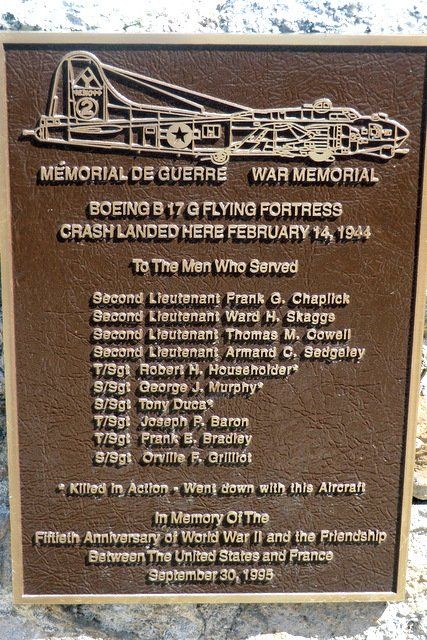


B17 FLYING FORTRESS-CALVI|HISTORIC WRECK
The 14 February 1944 mission was to bomb the railroad yards at Verona, Italy. Because of severe fog and undercast, the formation could not locate the target (no mention of heading to secondary target or targets of opportunity). Frank C. Chaplick’s aircraft was hit by about 12 enemy aircraft over the target area. Two engines were knocked out and the aircraft began skidding toward the outer edge of the formation. As a straggler, the enemy aircraft singled it out and concentrated their attacks upon it. The tail guns jammed when the first enemy aircraft attacked. A second enemy aircraft, realizing that the tail turret was inoperative, closed to point-blank range from astern before firing.
This aircraft killed the radio operator, one waist gunner, the tail gunner, and severely wounded the remaining waist gunner as well as inflicting light wounds on two others. The third fighter to attack was shot down (exploded in the air) by the wounded top turret gunner, Sgt. Frank E. Bradley before his turret also became inoperative. The fourth fighter was shot down by ball turret gunner Orville F. Grilliot. The navigator and bombardier combined to shoot down a further enemy aircraft before American P-47s arrived to drive off the onslaught.
With 2 engines in fire and a third with cough, there was nothing left to do, even holding the commands. One of P-47 escorted B-17G and the pilot took a direct course to Corsica. Then, a call with the Calvi’s control tower let the crew know that the landing track was too short to receive a damaged plane of B-17G size.
At Chaplick’s order, Bradley and Grilliot worked to lighten the load, throwing overboard as much equipment as possible. In the sight of the field at Calvi, a third engine quit and Chaplick had no option but to ditch, with the aircraft landing in the sea about 100 yards offshore. Except for the pilot and the co-pilot, the remainder of the crew gathered in the radio compartment with two of the dead for the ditching. Sedgeley, the bombardier, tried to get Tony Duca out of the tail turret to apply first aid but found him dead. That’s the way Frank G. Chaplick landed the B-17 on the water, very close in front of the Calvi’s citadel. The plane didn’t break during the operation and floated a few minutes, which enabled crew to evacuate it, except for the three machine gunners killed during the attack and whose bodies sunk with the wrecks. The crew managed to deploy and get into the life rafts but were unable to bring the three dead crewmembers with them.
After this difficult mission, the second lieutenant Chaplick went back definitively to the USA, the war for him was ended. The wreck is located 200 m in front of the port of Calvi at the height of the citadel.
DIVING SITE The wreck is still very well preserved and a popular diving destination. The wings are almost intact and the four engines are visible. Unfortunately, most of the propeller blades were removed. The nose was destroyed by the impact. The cockpit with its two metal seats and the intervening instruments are still quite well preserved. A little further away are the remains of the stern and a tail wheel.
The wreck lying at -27m depth in a sandy bottom. In the Calvi promenade, we can met a plaque honoring for the 50 years the crew fallen.


